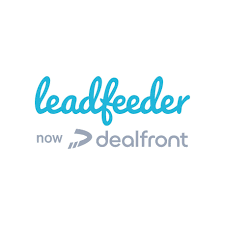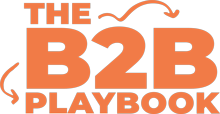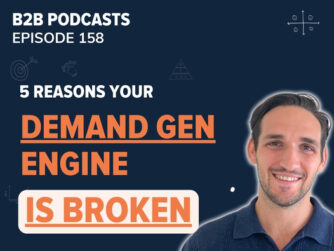As a battle-hardened B2B marketer, I know first-hand how important the right tech stack is in driving a high-impact demand gen strategy. But with every tool out there promising a ‘250% ROI’, and every team dealing with budget constraints, you need to know which ones are actually worth it.
Every tool we discuss today is one that we use in our own B2B tech stack – either for ourselves or for our clients. Most (if not all) have a free tier for you to get started with too.
We’ll cover tech we use at each stage of the funnel (or as we say, 5 Stages of Awareness). We include tools to generate/create demand (including content creation), prospecting and sales & marketing alignment, and tracking and reporting.
This is part of our Demand Gen mini-series. You can access the full series and their whiteboarding sessions here:
- What is demand generation? (part 1)
- When is the right time to start demand generation? (part 2)
- What companies are suited to demand generation? (part 3)
- How to build a winning business case for demand generation? (part 4)
- 10 questions to decide if you should build a new demand gen strategy (part 5)
- 5 steps to transition from lead gen to demand gen (part 6)
- Our B2B Demand Generation framework, The 5 BEs (part 7)
- Content That Generates Demand (part 8)
- Budgeting for Demand Gen – creation vs capture (part 9)
- Demand Generation KPIs (part 10)
- B2B Demand Generation Marketing Tech Stack (part 11)
- An introduction to Sales & Marketing Working Together (part 12)
- Our Sales & Marketing Alignment Workbook (part 13)
- Build Your Demand Generation Engine in our 12 Week Course
As per usual, you can read, watch or listen below to work through our favourite B2B Demand Gen tech stack.
Listen To The Episode
This episode is sponsored by Leadfeeder. Know EXACTLY who is coming to your website, convert more leads and get a free trial at Leadfeeder.com.
➡️Grab your Leadfeeder extended premium trial here

Watch The Episode
B2B Tech Tools for Demand Gen and Raising Brand Awareness
Let’s first look at the tools we use to raise awareness of our brand The B2B Playbook. The goal here is to bring our ICP (B2B Demand Gen Marketers) into our world, educate them on what great B2B marketing looks like and to earn their trust.
B2B Tech to Automate LinkedIn Connect Requests to Build Your Audience
After speaking with our Dream Customers, we realised that LinkedIn was a channel that many of them were on to either look for new job opportunities, or to learn from others. That’s why we decided to share the best of The B2B Playbook by posting there every day, for pretty much 2+ years straight!
But when we started out, we had 0 network on LinkedIn. We found that the easiest way to make people aware of our content was to add them into our network. So for a while, we diligently sent 20 connection requests per day to our Ideal Customers that would benefit from our content.
This became quite time consuming, so we solved for this by adding Dripify to our tech stack. Dripify takes a list of our ICP that we built in LinkedIn Sales Navigator, and connects with them through a simple sequence.

We regularly feed it lists of people who:
- are from companies in our ICP that have visited our website
- follow our company page The B2B Playbook but I’m not connected with personally
- have viewed my LinkedIn profile recently and are in my ICP
We don’t use the automated messaging feature to try to sell to people. It’s a very soft first connection, and the goal is to bring them into your world so you can deliver them value.
This is a great tool for founder-led brands to build their network on autopilot. It’s also great for your sales team or evangelists who are consistently delivering value on LinkedIn.
FYI – we recommend Dripify so often that we became an affiliate. If you feel like checking out the tool yourself, please use this link here. If you end up subscribing to it, there might be enough commission to buy Kevin and I a few cups of coffee 😂
By the way – we share the exact sequences we use in our 12 week demand gen training course, The B2B Incubator.
Content Tools in our B2B Tech Stack – Recording and Editing Our Podcast
We use a content repurposing system to output a wild amount of content every week in about 5 hours. This 5 hours gets us:
- 40 minute podcast
- 40 minute YouTube video
- 1x article
- 12x LinkedIn posts
- 1x newsletter
- 12x YouTube Shorts
And we do this every week with the following tools.
We use Squadcast and Descript to record and edit our podcast. Squadcast is our go-to platform for recording clear audio and video. It records a super high quality version that it uploads while you’re recording – to make us sound and look as good as possible. We used to use Riverside.fm, but have run into too many technical issues when recording (like a loss of audio and video). The support does its best for you, but we’ve been burned too many times and switched to Squadcast.
Once we’ve done our recording, we use Descript to help us edit. This beast of an editing tool lets us whip that raw audio into shape, clean it up, add those slick transitions, and get it ready for repurposing across every channel imaginable.

We’ve spent time creating templates for Descript so it’s easy to apply ‘scenes’, intros and outros. This massively cuts down any editing time for YouTube or creating snackable shorts.
Using AI in our Demand Gen Tech Stack To Help Repurpose Content
But here’s where things get really spicy. We’ve worked really hard to best use AI to turbocharge our content game. We use Claude.ai and ChatGPT to give us a hand in taking that pillar content, and giving us a big head start in repurposing it for the channels we need.
They analyse our podcast transcripts, extract the best quotes and key points, and even suggest section headers and titles that has our audience (hopefully!) hooked from the first line. It’s like having a team of content ninjas working around the clock to transform our insights into all the separate pieces of content we need – all while maintaining that signature B2B Playbook quality. It’s a big force multiplier for us.
The free versions of both should be enough for you to get started. The key is developing a prompting framework that gets the output you want again and again.
LinkedIn Analytics and Posting Tool to Optimize Distribution for Demand Gen
When it comes to amplifying our content and maintaining a consistent presence on LinkedIn, we use AuthoredUp. It’s a great tool for drafting, scheduling, and analysing our LinkedIn posts so we can get better and better.
The tool allows us to batch create and schedule updates weeks in advance, so our audience of B2B Marketers are fed a steady stream of value-packed insights and tactical advice every day.

But one thing I really love about it is its analytics capabilities. This tool keeps a meticulous record of every single LinkedIn post we’ve ever published, providing us with in-depth visibility into essential metrics like reach, engagement, and more.
With just a few clicks, we can instantly recycle our top-performing posts, maximizing their impact and ensuring our best content continues to work its magic.
I know there’s lots of other content scheduling and analysis tools out there, but as a business that has invested heavily in LinkedIn, AuthoredUp matched our needs best as that’s the channel it focuses on.
Recording Conversations for Customer Research
A key driver of your content should be the conversations you’re having with your audience, prospective customers and current customers. We are always collecting insights directly from them to feed back into our content.
We find the best place to record these conversations for customer research is either Dovetail or Fireflies.ai.
Dovetail is a purpose built platform for customer research. We did an episode with customer research expert Ryan Gibson, showing how to use the platform here.

Fireflies.ai (pictured above) however is what we use day-to-day to record our conversations for analysis and insights.
Demand Gen Tools for Creative at Scale
When you’re creating a lot of content, you need a lot of visuals to complement it. Canva is our weapon of choice here. We had my sister Katerina Coudounaris (graphic designer) whip up a whole arsenal of on-brand templates from day one.
They’re built in accordance with our guidelines which has allowed us to maintain a consistent brand from the beginning. We’ve built templates so we can easily create:
- YouTube thumbnails
- Blog post covers
- Presentation decks
- Summary documents
- Carousels
- Podcast episode covers
And much, much more.

If you want this built for yourself, check out her website Kat Couda Designs or email hello@katcoudadesigns.com. Tell her The B2B Playbook sent you to get access to our special partnership rate!
Demand Gen Tools for Prospecting and Engaging our ICP
In the previous section we looked at the tools that help us create demand (or build brand affinity – whatever you want to call it!). In this section, we’re looking at tools that help us prospect potential customers that may be engaging with our brand to either nurture them, or hand over to sales if ready.
Our Tech Stack to Track & Identify Anonymous Website Visitors and Capture Demand
Don’t you wish you could see which companies are checking out your website? Well – you actually can, using software like Leadfeeder, Factors.ai and Clearbit. These platforms allow us to pinpoint which companies, even those not currently in our CRM, are visiting our website and expressing interest in our offerings.
It’s not 100% perfect, but they can identify around 60% of these anonymous visitors, providing us with valuable intelligence that would otherwise be lost.

Armed with this data, we can take action to nurture these promising leads. Whether it’s launching targeted ad campaigns, connecting on professional networks like LinkedIn, or executing a well-crafted outbound strategy, we have the ability to reach out to these prospects while their interest is piqued.
Furthermore, these tools enrich the company data with additional details such as contact information and demographics, enabling us to personalize our approach as much as possible.
Lead Enrichment Tools in our B2B Tech Stack
At the point you want to make contact with a prospect, it’s important to have as much accurate information about them as possible. The more accurate your information, the more relevant you can be when you make contact. And the more relevant you are, the more likely it is you’ll get a response!
So to enrich our data, we use platforms like Clearbit, Apollo, and Instantly.ai.

With just a few clicks, we can enrich our lead records with critical intel like up-to-date contact information, job titles, company size, industry verticals, and much more. This granular level of insight allows us to hyper-personalize our outreach and messaging, ensuring we’re always speaking directly to the pain points and challenges faced by our ideal customers. It’s all about maximizing the impact of every single interaction, and having the richest, most comprehensive data at our fingertips is key to making that happen.
Our other primary tool for enrichment is LinkedIn Sales Navigator.

We regularly use this to collect more information on people who have been engaging with our assets, or to track down members of a buying committee that we’re missing.
We also use it to find more new prospects that fit our ICP so we can reach out to them, pull them into our network, and educate them for free.
Exporting Data from LinkedIn Sales Navigator
To export data from LinkedIn Sales Navigator into a spreadsheet so we can upload it into other platforms (for ad campaigns or outbound email), we use Evaboot.

Not only will it export your data for you, but it tidies it up and can find and verify emails to match it too. Very handy!
Our CRM, MAP and CMS for our Demand Gen Tech Stack
At the core of our lead management and nurturing efforts is HubSpot, a powerful all-in-one solution that serves as both our CRM and marketing automation platform. Hubspot sucked us in with their free tier initially. We’ve found it to be pretty great as a central platform for our entire sales and marketing operations. It houses a centralized database of every lead, prospect, and customer we interact with.
Hubspot also has great marketing automation capabilities to allow us to consistently nurture our audience. We can also use it to score leads based on their engagement levels and behavioural data. They also just purchased Clearbit at the end of 2023, so I’m pretty excited to see how they integrate that data into their platform.
We use WordPress as our CMS. It’s what powers The B2B Playbook website. I love how easy it is to use and to quickly get new pages and posts up and running. No complaints here!
Outbound Tools in our Demand Gen Tech Stack
Our business has been built on inbound, but lately we’ve started to also explore going ‘outbound’ to companies that we know are aware of our brand. To help us do this, we’re testing outbound tools Instantly.ai and Apollo.io.
Both are great for curating hyper-targeted contact lists and help you craft great copy and cadences. What got us to use Instantly.ai first over Apollo.io is their advanced email warmup and deliverability features. This takes a new domain that you’re using for outreach and ‘warms it up’ to ensure our messages actually land in inboxes, bypassing those pesky spam filters.

Both platforms give you great in-depth analytics tracking open rates, click-throughs, and engagement signals, allowing us to continually refine our outbound tactics for peak performance.
Instantly.ai also have amazing resources and onboarding guides to train you to become an outbound expert. Highly recommend!
Reporting Tools in our Demand Gen Tech Stack
Now let’s get to the tools that we use in our B2B tech stack for reporting – both to the wider business and for our own use!
Hubspot allows you to build out very flexible dashboards to track almost everything you need.

But lately I’ve preferred to use Factors.ai to bring all of our data under one roof and track the effectiveness of our marketing and sales efforts.

It’s great for seeing what efforts are driving pipeline. It’s also fantastic for pushing data and audiences into other platforms like our advertising and outbound platforms.


Probably one of my favourite features of Factors.ai is that it’s fully integrated with LinkedIn, meaning you can see the list of companies that you’re showing your ads to, and whether or not they’re engaging.

This is really handy to see exactly which companies our ads are being served to, so I know they’re going to our ICP and who is more likely to be a good candidate for some warm outreach.
We also subscribe to the free tier of Dreamdata which gives you information on who your ads are being shown to. Definitely worth checking out too.
Other Reporting Tools in our Tech Stack
Some other reporting tools we use in our tech stack include:
- Google Analytics – to track all of our website activity
- Google Search Console – to keep an eye on how our website is performing organically
- Google Tag Manager – to quickly deploy tracking and changes to our website
- Microsoft Clarity – our favourite (free) tool to review heatmap and video sessions to see how people are interacting with your website and landing pages
Action Steps to Choose Your Own Tech Stack
Okay, so that’s the tools Kevin and I are currently using for our own business or for our clients. Here’s what you should do next:
- Audit your current marketing technology stack to identify any gaps or underutilized tools. Don’t be afraid to experiment with new solutions – there’s a lot you can get on a free tier!
- Prioritize implementing essential components like website visitor identification software, a robust CRM + marketing automation platform, and comprehensive reporting/analytics capabilities.
- Explore automation tools that can streamline critical processes like LinkedIn outreach, content creation/repurposing, and personalized outbound campaigns.
- Leverage AI assistants to multiply your content production capabilities through intelligent repurposing and optimization.
- Continuously evaluate and optimize your tech stack as your business needs evolve, always seeking opportunities to operate more efficiently and drive better results.
Remember, technology is meant to be an enabler, not a hindrance. Be thoughtful when you curate your B2B demand gen tech stack, and tailor it to your needs. Book some time in the calendar every quarter or six months to evaluate it in the same way you would an employee – are you getting value from it? Is your team using it? Otherwise, it might not be worth keeping.
These are all tools that we discuss in the Live Q&A component of our Demand Gen Course – The B2B Incubator. If you want to get into the nitty gritty of each of these, I suggest you check out our 12 week program here.








